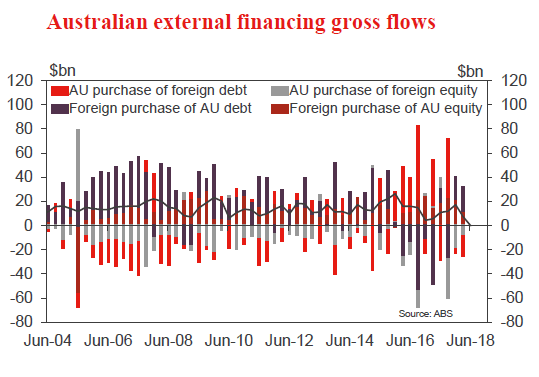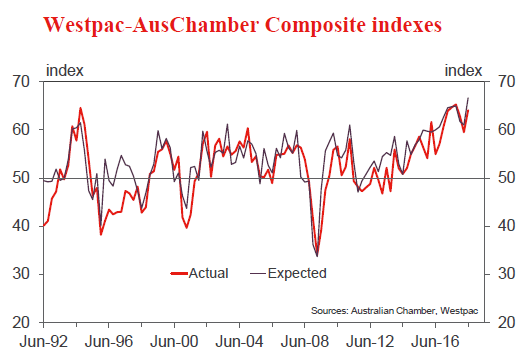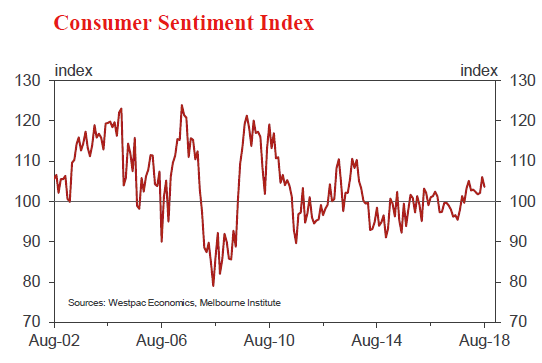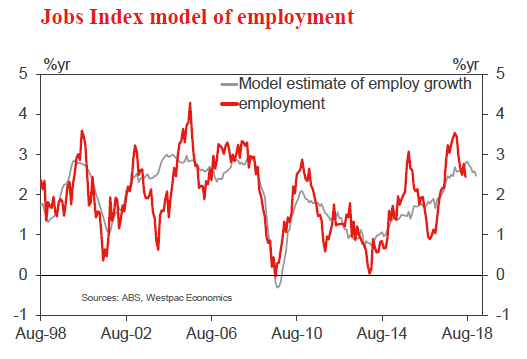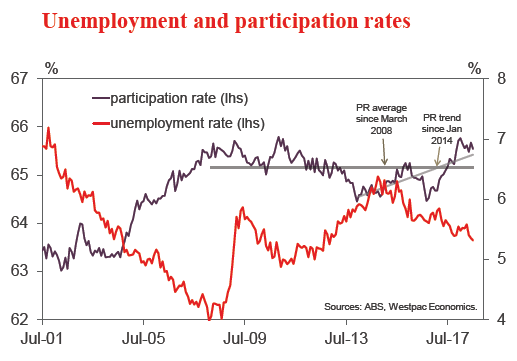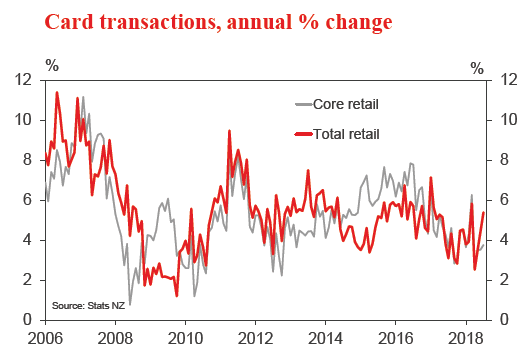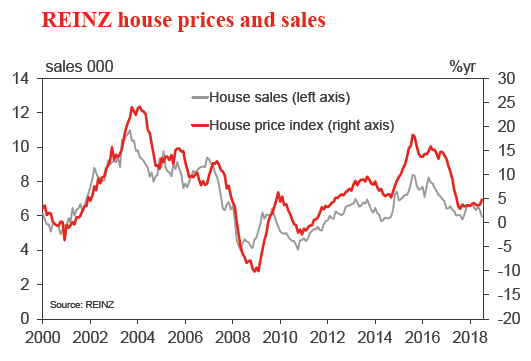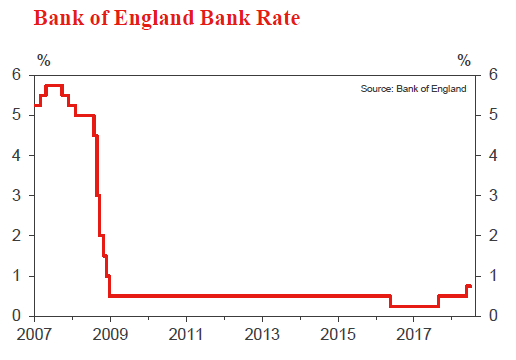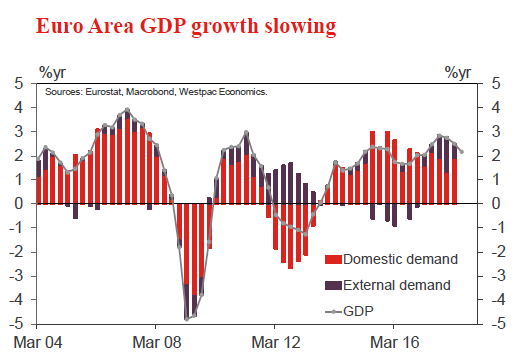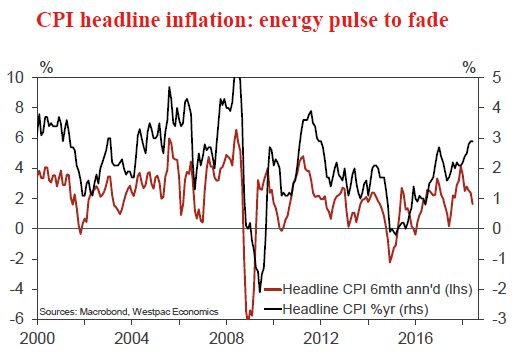Week beginning 10 September 2018
- We still expect a growth slowdown in 2019 despite recent strong GDP report.
- Australia: Westpac-MI consumer sentiment, Westpac-AusChamber survey, employment, RBA Assistant Governor Bullock speaks.
- NZ: retail card spending, house sales and prices.
- China: fixed asset investment, retail sales, CPI.
- Europe: ECB policy decision and forecasts.
- US: CPI, retail sales, Federal Reserve Beige Book.
- Other central bank meetings: BoE, Central bank of Turkey, Central Bank of Argentina.
- Key economic & financial forecasts.
Information contained in this report current as at 7 September 2018.
We Still Expect a Growth Slowdown in 2019 Despite Recent Strong GDP Report
The June quarter GDP report was released this week. Due to upward revisions of around 0.5 percentage points, the Australian economy was revealed to be much stronger than we had been led to believe.
Real GDP expanded by a solid 0.9% in the June quarter and annual growth printed 3.4% – well above potential of around 2.75%. Markets were expecting annual growth of around 2.8% with most of the lift being attributed to revisions of earlier quarters.
These accounts have prompted a review of our growth outlook.
We have lifted our growth forecast for 2018 from 2.7% to 3.3%.
The growth forecast for 2019 has been lifted from 2.5% to 2.7% and the 2020 forecast has increased from 2.8% to 3.0%.
While the levels of the growth forecasts have been lifted, the profile of an economy that will slow into 2019 and lift modestly in 2020 remains.
Furthermore, these growth rates (following 2.4% in 2017) are insufficient to make any meaningful impact on the spare capacity in the economy and therefore our inflation and wages forecasts remain essentially unchanged.
Our key themes over the forecast period remain intact:
- House prices in Sydney and Melbourne are now falling and this process is expected to persist through the remainder of 2018, 2019, and well into 2020. The adjustments will be shallow but persistent. That process will see consumption per capita which has been running at a pace slightly above household income per capita drop below that pace. We also expect total labour income growth to slow from 5% in 2017, to 4% in 2018, 3.6% in 2019, and drifting back to 4% in 2020. Slower income growth complemented by the expected wealth effect should see consumer spending growth slow from the current 3% to a more modest 2.6% in 2019 and 2.8% in 2020.
- We expect global growth to slow from 3.8% in 2017 to 3.5% in 2020. That slowdown in global growth through 2019 and 2020 reflects China on a steady downswing (down to 6.0% growth in 2020); US slowing from mid-2019 (partly under the weight of persistent Fed tightening – US growth to slow to 1.7% in 2020; Japan responding badly to the introduction of a consumption tax in 2019 (growth slowing to 0.7% in 2020); European growth dropping below trend as the ECB stops QE (back to 1.5% in 2020); trade disruptions; and ongoing adjustments being required in those emerging markets that may be exposed to US interest rates, a strong USD, and higher oil prices.
- While we have been surprised by the data revisions to the housing construction cycle (dwelling investment growth for the September to March quarters was revised up from minus 1.3% to plus 2.2%) a slowdown seems highly likely. Strong population growth will be insufficient to counter slowing foreign investment; credit tightening by the Australian banks; current increases in mortgage rates; and prospects of tax changes following next year’s election.
- Political uncertainty looks set to weigh on firms’ investment and employment intentions through the remainder of 2018 and 2019. These factors have played out clearly during the election campaigns of 2013 and 2016.
- The drought will weigh on farm exports and rural investment and consumption through 2018/19.
Nevertheless we have factored in a number of positives over this period that were apparent in the national accounts and partly responsible for our modest lift in growth forecasts.
- New dwelling investment is reported to have boomed at a 14% annualised pace in the first half of 2018. That current momentum indicates that the expected contraction in investment will be delayed. That contraction will include renovation spending as home owners respond to falling house prices.
- Public demand was reported to have grown by 5% over the last year. Governments are playing catch up, investing particularly in transport infrastructure and boosting health expenditure to meet the needs of a rapidly growing population. We are now expecting that momentum to hold for longer. We have raised our profile for public demand growth over 2019 and 2020 from 3.8% (2019) and 3.6% (2020) to 4.3% (2019) and 4.0% (2020).
- Recent surveys of investment intentions have not been encouraging. In the June quarter, equipment investment contracted for the first time since September quarter 2016. However we are lifting our estimate of the strength of the spill-over from government spending to private investment and, while still slowing, have modestly boosted our profile for non-mining business investment.
- The accounts highlighted some improvement in wages growth. Queensland and Western Australia have lifted to 5.8% (annual), now exceeding NSW (4%) and Victoria (4.7%). That development highlights the recovery in income growth in the mining states and signals a somewhat more buoyant outlook as the drag from the mining states subsides.
- While our slowing global growth outlook will impact confidence and the terms of trade, China’s policies around addressing pollution have boosted demand for LNG and high quality Australian iron ore, disturbing the “normal” relationship between global growth and Australia’s key commodity exports.
- The stronger current growth will boost the finances of governments, both state and federal. That will allow governments to continue to pursue their expansionary spending and investment programs and may stimulate a lift in Federal Government spending plans as the parties vie for popular support.
These revised growth forecasts do not change our forecasts for monetary policy. We still expect the RBA cash rate to remain on hold through to the end of our forecast horizon – 2020.
The key here is that following a 2.4% growth rate in 2017, the economy will only register a single above potential growth performance before slowing back to slightly below potential in 2019 with a modest above potential lift in 2020.
There is unlikely to be much sustained progress in closing the output gap and delivering higher wage and price inflation outcomes.
The week that was
June quarter GDP for Australia was our focus this week. It offered a positive surprise versus expectations, and will provide the RBA with comfort regarding the outlook.
In terms of headline GDP, the 0.9% gain for Q2 2018 was 0.2ppts above the market’s expectation. See the essay above for the impact on our forecasts.
Within the GDP detail, clearly evident was the importance of population growth to aggregate momentum. Note that against the 3.4%yr outcome for GDP overall, GDP per capita was much weaker at 1.8%. Albeit materially above the post-GFC per capita average of 1.1%yr, it is (in contrast) well below that experienced between 1993 and 2007 (2.5%yr). This strength in population growth helps explain two key aspects of our aggregate growth story: the need for strong public investment; but also the subdued consumer.
Public (government) demand has been surging for over three years now, as state governments sought to catch up on investment that should have already occurred while population growth continued to run well ahead of historical norms. Unsurprisingly, where population growth has been strongest, so too has public demand. Against growth of 4.8%yr for the nation overall, in Victoria it has risen 8.1%yr. At the other end of the spectrum is South Australia, where public demand is currently down 2.6%yr. Importantly for the outlook, the national pipeline of projects is large and growing. Victoria and NSW will continue to drive aggregate activity, but other states are now also coming to the party – Queensland being the prime example. Population growth and government spending also have flow-on benefits for private sector investment, particularly the construction of new health; education; and short-stay accommodation facilities as well as offices. Victoria is again the prime example, with private non-residential construction and infrastructure work up 12%yr and 14%yr respectively.
Turning then to the subdued consumer. Population growth typically offers great opportunities to the existing population as activity and employment increase. However, if the rate of per capita growth is not sustained, then total income has to stretch further. Notable in Q2 2018 was that compensation per employee rose just 0.1%, keeping annual growth at a soft 1.8%. Significantly, the non-mining states (where activity and employment growth has been strongest) have seen a moderation in wage/ salary growth of late. Incorporating the other components of household income, and taking inflation into consideration, we are left with annual real household income growth of just 1.6% over the past 12 months, following no net gain for the past six months. These outcomes explain why the savings rate has fallen to just 1.0%, a level we have seen breached rarely and only briefly. It is not surprising then that consumer spending remains sub-par, both in aggregate and per capita terms.
Looking ahead, the RBA expects momentum to remain robust, forecasting growth “a bit above 3 per cent”. This view is predicated on the unemployment rate continuing to trend down to around 5% and improving wage growth, both of which would support stronger consumption growth and associated business investment. We have doubts over employment and wages growth, and are also mindful of a potential negative wealth effect from house price declines. Further, for housing investment, financial conditions have clearly tightened, reducing demand for new construction. Albeit only to July, the latest retail sales detail highlights considerable uncertainty around consumer spending as we move into the second half, with tentative signs of spill-overs from the decelerating housing market. If sustained, this trend will weigh further on retail sector profits and these businesses’ willingness to invest and employ.
Elsewhere in the world this week, PMI data was the focus. For the US, it was unequivocally strong. Most notable was the ISM manufacturing survey at a 14 year high on broad-based strength. For China, while external demand has softened, domestic orders have held up well, particularly given the marked deterioration in investment growth. Important for aggregate activity, employment growth has also shown resilience. Indeed, the official NBS PMI’s have reported an acceleration in employment growth of late (though we must caution that the Caixin measures, which focus on smaller firms, have reported the opposite). In the rest of the Asian region, India and Indonesia were shown to be carrying strong momentum at June as they come face to face with multiple headwinds related to emerging market capital flight; consequent monetary policy tightening; and the ill effects of higher inflation on discretionary household incomes. The region has a bumpy road ahead of it, but structurally speaking, they are well placed to weather the storm. Speaking of which, the coming week is likely to see an announcement made by the Trump administration on the next round of tariffs (on $200bn of imports from China). Ahead of this, China has again emphasised they will respond to any intensification of hostilities.
Chart of the week: Financial Accounts
Ahead of GDP, we also received an update on foreign investment in Australia. The key theme from this release remains the strength of direct investment into Australia. Despite the mining investment boom having well and truly ended, foreign investors continue to show strong interest in Australian assets – from individual office buildings to listed companies. Interestingly, as these current investments typically involve the purchase of existing assets, the funds that are flowing into Australia are in the form of equity capital. Highlighting this, new loans from foreign parents represented just 2% of direct investment in 2017 and 2018-to-date compared to over 20% between 2014 and 2016. Apart from direct investment, Australian firms appetite for debt financing from offshore also remains limited. The past year has seen Australian corporates raise $12bn offshore to fund domestic operations; however this follows a $15bn reduction in the stock between Q2 2015 and Q2 2017.
New Zealand: week ahead & data wrap
Quiet achievers
The drivers of New Zealand’s economic growth are changing. As construction, population growth and the housing market retreat, other sectors are stepping up. One of these is the external sector. New Zealand’s terms of trade is back within reach of its late-2017 record high on the back of strong prices for commodity exports. Recent data shows services exports have also been stronger than previously reported. The buoyant export sector is supporting growth prospects in many regions, as outlined in our recent Regional Roundup report.
New Zealand’s external sector is stepping up to the plate as previous drivers of New Zealand’s economic growth start to slow. As evidence of this, New Zealand’s terms of trade – the ratio of New Zealand’s export prices to import prices – rose by 0.6% in the June quarter. Export prices were up 2.4% in NZ dollar terms in the quarter, with higher prices almost across the board for New Zealand’s main commodity exports. The 1.7% lift in import prices was propelled by a 10% jump in oil prices and a small drop in the exchange rate.
While the export story remains a strong one, this could be as good as it gets for the terms of trade for a while. Key commodity prices have moderated in recent months, most notably dairy prices. The recent run of soft GlobalDairyTrade auctions continued this week, with the headline GDT price index edging 0.7% lower. On this measure, dairy prices have fallen around 13% since the start of the local 2018/19 dairy season. The weaker New Zealand dollar has only partially offset the impact of these falls on farmgate prices.
For our part, an expectation of softer dairy prices over the second half of 2018 has underpinned our $6.50 milk price forecast for some time. In contrast, Fonterra has taken longer to come around to this view, only downgrading its milk price forecast last week. We still think Fonterra’s new $6.75 (previously $7) milk price forecast is too optimistic. Indeed, we are wary of the downside risks to our own $6.50 forecast, which is contingent on whole milk powder prices remaining around current levels before improving gradually in the New Year. Further falls in whole milk powder prices from here would have us reassessing this outlook.
Yet New Zealand’s export sector is no longer all about commodity exports. Tourism is booming, the international education market has grown strongly of late and business services (including the likes of ICT, intellectual property services and financial intermediation services) has expanded as technological developments have helped alleviate New Zealand’s geographic disadvantage. These quiet achievers really should have been enjoying star billing in recent years.
Indeed, Stats NZ data released this week showed this was the case to an even greater extent than we previously thought. New Zealand’s exports of services have been revised significantly higher. Most notably, the annual update of international student spending was stronger than anticipated. In addition, Stats NZ is now capturing spending by visitors on cruise ships in its data. This, combined with other changes, has led to exports of services being revised up as far back as 2013. Where it has its maximum impact, the changes add an additional $1bn to exports of services in the March 2017 year.
Not only does that mean the external sector was doing even better than we gave it credit for in recent years, it also means our external accounts are in an even healthier position than we previously thought. The new data implies an improvement in New Zealand’s current account in the order of 0.3% of GDP at the height of its impact, meaning NZ’s current account deficit probably improved to 1.9% of GDP in 2016.
The flip side of the terms of trade is import prices, not least oil. Oil prices have exceeded expectations in recent months in part due to supply disruptions in Venezuela and Angola. Other OPEC producers have declined to step in and fill the void to date, meaning tighter supplies and higher prices. We still expect prices will moderate next year, as supply from other oil producers including the US increases, but we think this change will happen more slowly than previously envisioned. That has important implications for our CPI forecasts. After updating for this new oil price outlook, we now expect inflation at the end of next year will be 1.6% (previously we were forecasting 1.3%).
The strong performance of the external sector has also been reflected in differences in activity amongst regions, as highlighted in our recent Regional Roundup report1. In general, activity levels in the major metropolitan regions have been more subdued than those in rural regions, a trend that continued in the latest quarter. Most notably, regional economic confidence (how surveyed households view prospects for their own region over the year ahead) was the weakest in Auckland as the pace of growth in the region slowed. With the housing market in Auckland likely to be hardest hit by government policy changes aimed squarely at investors, the region is also likely to remain more subdued going forward than other parts of the country.
In contrast, traditional tourist hot spots, particularly those with significant exposure to the high flying horticulture sector, such as the Bay of Plenty, Otago and Gisborne/Hawke’s Bay continue to be amongst the most buoyant parts of the country. Add to that prospects for a lift in regional investment on the back of the launch of the Government’s Infrastructure Growth Fund and it’s likely that the regions will continue to outperform metropolitan areas even as the overall pace of growth slows right across the country.
Data Previews
Aus Q3 AusChamber-Westpac business survey
- Sep 11, Last: 63.8
The Australian Chamber-Westpac survey of the manufacturing sector provides a timely update on conditions in the sector and insights into economy-wide trends. The Actual Composite tracks a range of demand related measures including investment and employment. The Q3 survey was conducted in August and into September.
In Q2, the Actual Composite rose to 63.8 from 59.4 in March. Strength is centred on a lift in new orders and output as well as increased. However employment moderated in June.
Manufacturing is benefitting from a rise in public infrastructure, non-mining business investment, and above par world growth with a relatively low AUD. However, there are likely to be spill-over effects from the drought in NSW and Queensland.
Aus Sep Westpac-MI Consumer Sentiment
- Sep 12 Last: 103.6
The Westpac Melbourne Institute Index of Consumer Sentiment declined 2.3% to 103.6 in August from 106.1 in July. The move gave back about half of the solid gains seen in June and July which look to have been partly a positive response to the tax cuts announced in the May Budget. The August reading was still positive overall, 5.5% above the average in 2014 to 2017 and the ninth successive month that above the 100 level, indicating optimists outnumber pessimists.
The Sep update may end that run. The survey is in the field from Sep 3-8 and is likely to be influenced by: the leadership change that saw a new PM announced in late August; and mortgage rate increases, with three of the four major banks lifting standard variable mortgage rates by 14-16bps. Continued slippage in house prices and financial markets – the ASX down 1.9% and the AUD down 1.6c vs the USD since the last survey – may also weigh on sentiment.
Aus Aug Labour Force Survey –Employment ‘000
- Sep 13, Last: –3.9k, WBC f/c: 18k
- Mkt f/c: 18k%, Range: -10k to 35k
Employment fell –3.9k in July coming in below market consensus expectation of +15k and met Westpac’s forecasts for –5k. The full-time employment recovery continued with a +19.3k gain in July (following +43.2 in June) while parttime fell –23.2k (it printed +15.0k in June). Hours worked increased by 0.2% in the month, which following on from the 0.6% lift in June, took the annual pace to 2.3%yr from 1.7%yr in June.
In July, the incoming rotation group has an employment to population ration lower than the group it replaced but on par with the sample as whole. We expected this and is why, in part, we forecast a small number. In August, the group rolling out is more like the sample overall so we will not speculate this month on the possible impact of sample rotation.
Our Jobs Index model suggests that labour demand may have eased but it still at a robust level. As such, we have forecast an around trend 18k for August.
Aus Aug Labour Force Survey –Unemployment %
- Sep 13, Last: 5.3%, WBC f/c: 5.3%
- Mkt f/c: 5.3%, Range: 5.2% to 5.5%
In the July Labour Force Survey, the fall in employment combined with fall in the participation rate (mostly due to the group rolling in being less attached to the labour force than the group rolling out) to 65.54% from 65.68% driving a –9.6k decline in the labour force.
As the decline in the labour force was slightly larger than the drop in employment, the unemployment rounded down to 5.3% (5.32%) from 5.4% (5.35%). So while it was reported a fall in unemployment, a 0.02ppt change as best described as flat.
Westpac’s forecast for an around trend rise in employment of 18k, and with the participation rate rounding up to 65.6%, will see the unemployment rate hold flat at 5.3%.
NZ Aug retail card spending
- Sep 11, Last: +0.7%, Westpac f/c: +0.5%, Mkt f/c: +0.5%
Retail spending levels rose by 0.7% in July, underpinned by increased spending on consumables (e.g. groceries), as well as an increase in fuel prices. Spending levels have been boosted by the Government’s Families Package, which has added to the disposable incomes of many households.
We expect a 0.5% increase in retail spending in August. However, with fuel prices pushing upwards, core spending growth is expected to be more modest at around 0.3%. Increases in disposable incomes are adding to spending in some areas like consumables. But at the same time, the continuing slowdown in the housing market is dampening spending on items like household furnishings.
NZ Aug house sales and prices
- Sep 14 (tbc), Sales last: -5.7%, Prices last: 4.9%yr
The housing market has generally been soft in recent months. Nationwide house sales have slowed, and prices in Auckland have drifted lower. However, prices continue to rise in most of the rest of the country, and there were signs that they gathered pace in July.
The outlook for house prices is caught between the Government and the RBNZ. Restrictions on overseas buyers were passed into law last month, and will take effect shortly. On the other hand, the RBNZ’s statement that it is nearer the trigger point for reducing the OCR has led to a drop in mortgage rates, which may already be giving some life to the market. • We expect nationwide average house prices to remain fairly subdued over the remainder of the year, with Auckland underperforming the rest of the country due to the greater impact of investor restrictions.
UK Sep Bank of England policy decision
- Sep 13, Last: 0.75%, WBC f/c: 0.75%, Mkt f/c: 0.75%
August saw the Bank of England raise the Bank Rate by 25bps to 0.75%. The BoE also maintained its very modest tightening bias, reiterating that future increases are likely to be “at a gradual pace and to a limited extent”. But despite the increase in the Bank Rate, the BoE’s discussion and comments from Governor Carney actually struck a mildly dovish tone.
With inflation contained, growth moderate, and Brexit casting a very long shadow over the economic outlook, the BoE is set to stand pat for an extended period. We expect no change at the September meeting. The accompanying statement is likely to retain the very gradual tightening bias from August, but more weight may be given to uncertainties around the economic outlook.
EA Sep ECB policy decision
- Sep 13, last –0.40%, WBC –0.40%
The ECB used the June policy meeting to affirm their forward guidance into 2019. It is very likely that the September meeting will continue the current stance with only minor changes to their activity forecasts.
In June, we were told that asset purchases will be tapered again from October before ending completely in December, and that interest rates are on hold until the end of next summer. Still-low core inflation and a continued reduction of slack in the labour market backs up this stance.
Since July’s meeting, GDP growth printed at 0.4% in Q2, following Q1’s 0.4% growth. Yet it is still a bit low relative to the ECB’s 2.1% 2018 forecast, reflecting a faster than expected easing from 2017’s brisk 2.5% year average pace as the boost from external demand fades.
In September, the ECB are likely to slightly reduce their growth forecast, but their view for unemployment and core inflation remains intact and consistent with June’s guidance.
US Aug CPI and retail sales
- Sep 13, CPI, last 0.2%, WBC 0.3%
- Sep 14, retail sales last 0.5%, WBC 0.5%
US inflation continues to print largely as expected, holding at its recent highs well above the FOMC’s 2.0%yr inflation target. Of late, energy and rents have remained key supports, so too base effects from 2017’s one-offs.
In Sep, energy will again be a factor, resulting in a 0.3% gain for headline prices against core inflation’s 0.2%. As 2018 winds down, CPI inflation will tend towards (but remain above) 2.0%yr, bringing these measures back into line with the less volatile PCE measures.
On retail sales, Jul saw a bounce back in spending albeit only after Jun was revised down. Another 0.5% gain is anticipated in Aug. Spending should be broad based, though increasingly autos are a risk given the effect of higher interest rates.




